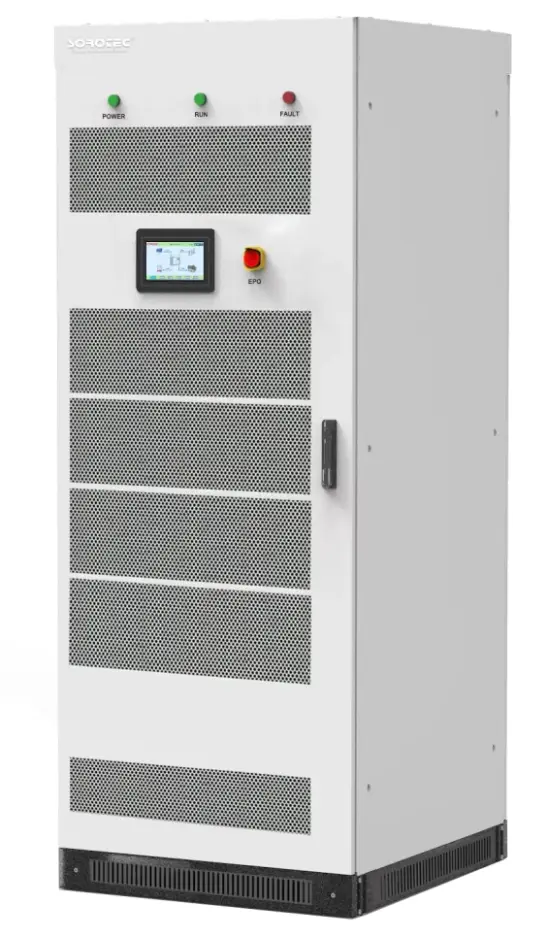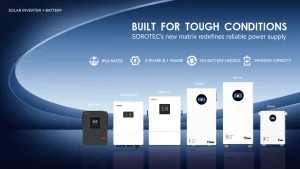In every power system, one basic mix-up can lead to large design errors — confusing true power (kW) with apparent power (kVA). For engineers, sellers, or building bosses handling big UPS and inverter setups, this gap can decide if the system works well or loses energy daily.
Companies like SOROTEC, a world supplier of power gear and storage tools, have made their products around this main idea: what counts most is how much real power a UPS can give to the load.

Why Should We Understand the Difference Between True Power and Apparent Power?
The topic might seem like school stuff. But in actual jobs, it’s quite useful.
Fundamental Concepts of True Power, Apparent Power, and Power Factor
True power, measured in kilowatts (kW), is the real energy that does helpful work. It runs motors, lights, or data servers. Apparent power, measured in kilovolt-amperes (kVA), mixes both active and reactive power. The tie between them is the power factor. It often sits between 0.7 and 1.0.
A system with a 0.8 power factor means only 80% of its apparent power is useful true power. The rest is reactive. It moves back and forth between the source and load.
How Power Factor Influences the Actual Output of a UPS System
In a UPS, the power factor sets how well it can send real energy to the gear. A high power factor, close to 1, means less lost energy. And it means smaller current for the same load. New SOROTEC systems hit power factors up to 0.99. So, they give buyers almost a one-to-one match between kVA and kW.
Importance of Accurate Power Measurement in Industrial and Renewable Applications
For factory users or solar mix projects, even a tiny wrong guess can cause overloads, often trips, or quick part wear. Measuring power right avoids these problems. And it keeps the system steady. SOROTEC thinks about this in every design step.
How Does True Power Impact the Performance of a UPS?
A UPS rated at 100 kVA doesn’t always deliver 100 kW. That’s why real power output is the key measure.
Real Wattage Delivery for Critical Loads and Sensitive Equipment
Factories, hospitals, and phone base stations rely on steady wattage, not just theory capacity. The more exact the UPS output, the safer the linked load. For instance, gear with switching power supplies or servers needs clean, stable wattage. Fluctuating apparent power can’t give that.
Power Efficiency and Heat Management in Continuous Operation
When the system makes too much reactive power, more current flows. This creates extra heat. Parts age faster. Fans run louder. And efficiency falls. By focusing on true power, workers cut waste. They keep inside temps in the safe area.
SOROTEC On-Grid MPGS Series Ensuring Stable AC Output
SOROTEC’s On-Grid MPGS Series (50 – 600 kW) shows this rule at work. The series uses a DSP control platform and IGBT modules. They deliver high-precision AC power with a nearly unity power factor. Whether set up in a business solar station or a work park, it holds steady output even during voltage changes. It’s real power, not just words on paper.

What Happens When We Size a UPS Based Only on Apparent Power?
This is a usual trap in buying and system planning.
Overestimation of Capacity and Unnecessary Cost Increase
Picking a UPS just by its kVA rating often leads to making it too big. The gear ends up larger, heavier, and pricier than needed. For big systems, that added capacity can mean lots of dollars wasted.
Risks of Undersizing Due to Ignoring Power Factor Corrections
The flip side is also true. A UPS rated at 50 kVA but with a 0.7 power factor gives only 35 kW of real power. If your machines need 40 kW, it will overload under full run. Skipping power factor fix during planning can shorten battery life. And it can cause stops.
Energy Loss, Voltage Drop, and Reduced Backup Efficiency
When reactive current flows without need, voltage drops grow. Cables heat up. And battery time shortens. These small flaws add up over months of steady use. They show why true power must guide the planning talk.
How Does SOROTEC Optimize True Power Output in Its UPS and Inverter Systems?
SOROTEC’s R&D team has spent years building answers that focus on giving actual wattage output under different loads.
Advanced IGBT and DSP Control Technology for High Power Conversion Efficiency
Each inverter in the MPGS series uses advanced insulated-gate bipolar transistors mixed with digital signal processors for quick control. This setup reacts right away to load shifts. It cuts waveform twist. And it keeps the output near the rated true power.
MPPT and Power Factor Correction (PFC) Functions in the MPGS Series
The MPGS systems blend multiple MPPT (Maximum Power Point Tracking) channels and auto PFC circuits. They balance reactive and active currents. This boosts real-time output efficiency for solar-plus-storage jobs.
Intelligent Load Management and Modular Design Enhancing Reliability
Modules can work alone or together. They share the load evenly. This stops too much stress on one inverter. And it keeps the total true power steady, even during busy hours or small faults.
How Can SOROTEC’s On-Grid MPGS Series Support Both True and Apparent Power Requirements?
The MPGS series is made for mix, grid-linked settings where both measures count.
Wide Input Voltage Range and Fast Grid Synchronization
The unit auto adjusts to grid changes. It handles voltage swings without cutting power. This wide range lets steady work under shaky local grids. That’s common in new markets.
Compatibility with Solar PV and Energy Storage Systems
Made for smart energy jobs, the system backs PV arrays, batteries, and generators. It can send power to the grid or feed loads straight. It changes its mode based on sun and need.
High Efficiency (up to 98.6%) Ensuring Maximum Real Power Utilization
In steady run, the MPGS inverter hits up to 98.6% change efficiency. That means almost all input power turns into usable AC output. It saves energy. And it makes gear last longer.
What Factors Should Buyers Consider When Sizing a UPS Based on True Power?
Sizing is more than just looking at the spec sheet. The real-world spot matters.
Load Type, Power Factor, and Application Environment
Different loads — inductive, capacitive, or resistive — pull power in various ways. Work motors need higher start currents. LED lights act unlike servers. Knowing each load’s power factor helps pick the right UPS size.
System Scalability, Parallel Operation, and Future Expansion
Many spots grow over time. Picking a modular UPS like SOROTEC’s MPGS lets extra units add later without new plans. This saves both room and cost for later growth.
Total Cost of Ownership and Long-Term Energy Efficiency
A UPS with higher true power output may cost more at first. But it saves energy, cuts downtime, and lowers cooling bills over years. Wise buyers look at life costs, not just the start price.
FAQs
Q1: What the main difference between true power and apparent power in simple terms?
A: True power (kW) is the usable energy that performs actual work, while apparent power (kVA) includes both useful and wasted power due to flaws or phase gaps.
Q2: Why do some UPS systems advertise both kVA and kW ratings?
A: Because makers want users to know both total capacity and how much of it can be used well. The closer those two numbers are, the better the power factor and efficiency.
Q3: How does SOROTEC’s MPGS Series help in reducing energy waste?
A: By mixing high-efficiency IGBT modules, power factor correction, and smart watching, the MPGS series changes nearly all input energy into usable AC output. It cuts heat, losses, and long-run costs.








